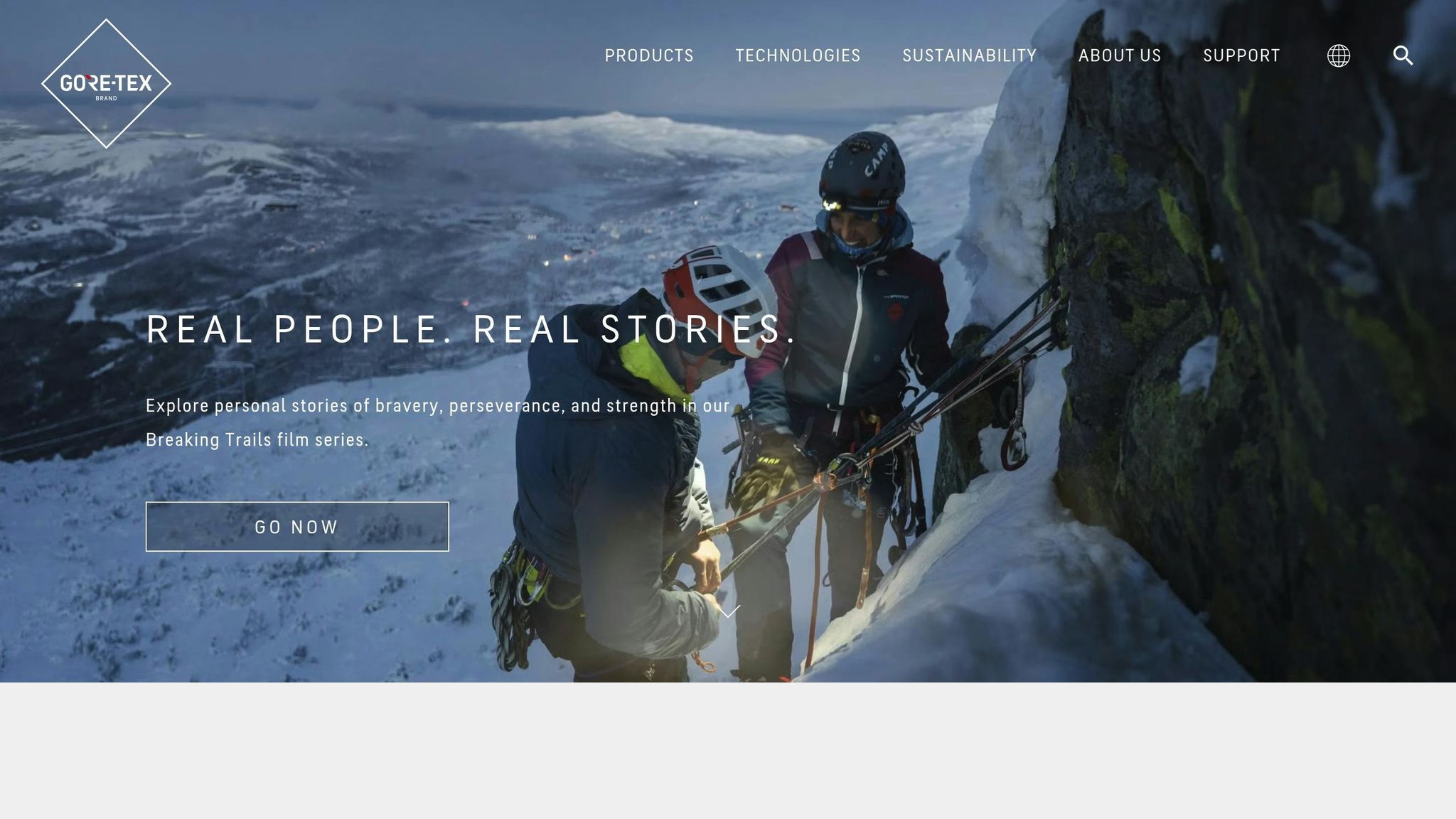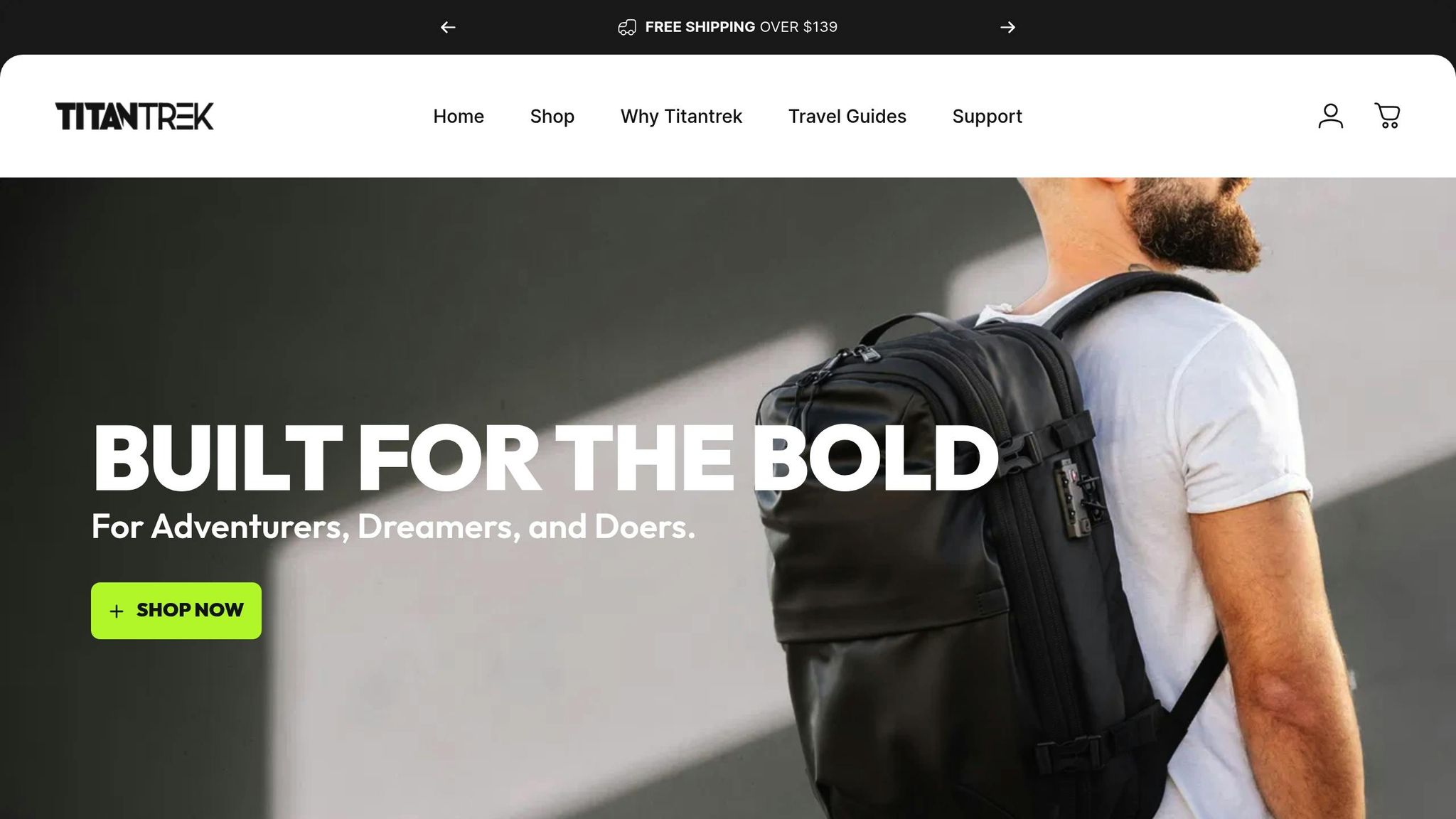Breathable travel gear is essential for comfort and performance during expeditions, whether you're hiking in heat, trekking through rain, or exploring rugged terrains. Here's what you need to know:
- Why It Matters: Breathable fabrics regulate temperature, wick sweat, and protect against weather.
-
Top Materials:
- Merino Wool: Regulates temperature, resists odor, and wicks moisture.
- Synthetic Fabrics: Durable, lightweight, and quick-drying.
- Gore-Tex: Waterproof yet breathable for extreme conditions.
- Bamboo: Naturally cool, UV-protective, and eco-friendly.
-
Key Items:
- 3-Layer Clothing System: Base (moisture-wicking), mid (insulation), outer (weatherproof).
- Breathable Footwear: Ventilated shoes/boots for comfort.
- Airflow Backpacks: Ergonomic designs with ventilation and compression features.
-
How to Choose:
- Match materials to weather and activity level.
- Prioritize durability, comfort, and multi-use functionality.
| Material | Moisture-Wicking | Odor Resistance | Durability | Best For |
|---|---|---|---|---|
| Merino Wool | Excellent | Excellent | Good | Multi-day trips, cold temps |
| Synthetic Fabrics | Excellent | Moderate | Excellent | High-energy activities |
| Gore-Tex | Very Good | - | Excellent | Wet or extreme conditions |
| Bamboo | Very Good | Good | Very Good | Warm climates |
Invest in quality gear to ensure comfort and functionality on your next adventure.
Lower Body Layers - Mountaineering Expedition Gear Guide
Why Breathable Materials Matter
Understanding how breathable materials work is crucial when picking the right gear for your adventures. These fabrics are designed to keep you comfortable and performing your best, no matter the conditions.
Temperature Control and Comfort
Breathable fabrics help maintain a stable body temperature by creating a balanced microclimate. When you're active, they release excess heat to prevent overheating. In cooler or less active situations, they help retain warmth to keep you comfortable.
Sweat Management and Quick Drying
These materials are great at wicking sweat away from your skin, keeping you dry and reducing the chances of chafing. Plus, their ability to dry quickly helps limit odor by slowing bacterial growth.
Weather Protection and Durability
Breathable fabrics offer some protection against wind and light rain, making them a practical choice for outdoor gear. For example, a waterproof, breathable backpack can protect your belongings while ensuring you stay comfortable during your journey.
Top Breathable Materials for Travel
Merino Wool Properties
Merino wool is known for its ability to regulate temperature and manage moisture effectively. Its natural crimp creates air pockets that provide insulation in varying temperatures. This material can absorb moisture while still feeling dry to the touch, helping you stay warm when needed. Plus, it naturally resists odors, making it a smart pick for longer trips.
Synthetic Material Benefits
Synthetic fabrics like polyester and nylon are designed for durability and moisture management. These materials are crafted with specific weaving patterns that pull sweat away from the skin, keeping you dry during high-energy activities. Synthetic clothing is lightweight, easy to pack, and stands up well to frequent use and washing.
Gore-Tex and Waterproof Materials

Gore-Tex fabrics feature a membrane with tiny pores that block water from entering while letting vapor escape. This design keeps you dry from rain while allowing sweat to evaporate, making it both waterproof and breathable. Advanced Gore-Tex Pro fabrics are rigorously tested to handle extreme conditions, making them a dependable choice for outdoor adventures.
Bamboo and Natural Fiber Options
Bamboo-based fabrics offer natural UV protection and wick moisture efficiently. The structure of bamboo fibers allows for excellent ventilation, helping you stay cool in hot weather. These fabrics also maintain their shape and function after multiple washes, making them a reliable choice for travel.
| Material Type | Moisture-Wicking | Odor Resistance | Temperature Range | Durability |
|---|---|---|---|---|
| Merino Wool | Excellent | Excellent | Wide range | Good |
| Synthetic | Excellent | Moderate | Versatile | Excellent |
| Gore-Tex | Very Good | - | All conditions | Excellent |
| Bamboo | Very Good | Good | Warm climates | Very Good |
These materials offer a variety of options to suit different travel conditions and needs.
sbb-itb-b1567d8
Must-Have Breathable Travel Items
When it comes to travel, breathable fabrics aren't just about comfort - they're about practicality. Here are some essential items that use breathable materials to make your adventures more enjoyable.
3-Layer Clothing System
A three-layer clothing system is key for staying comfortable and protected during expeditions. Each layer serves a specific purpose: managing moisture, regulating temperature, and shielding you from the elements.
- Base Layer: Start with a moisture-wicking fabric like merino wool or synthetics. Lightweight options work well in warm weather, while slightly thicker ones are better for cold conditions, all without compromising airflow.
- Mid Layer: This layer provides insulation by trapping body heat while still allowing moisture to escape. Lightweight fleece or wool blends are excellent choices for warmth that doesn't stifle.
- Outer Shell: The outer layer should block wind and rain while preventing overheating. Look for waterproof jackets with built-in ventilation features to help maintain a comfortable body temperature.
Travel Shoes and Boots
Your footwear matters, especially during long trips or hikes. Opt for shoes and boots with breathable mesh panels and moisture-wicking linings. For versatility, pack lightweight shoes for casual activities and sturdier, ventilated boots for rougher terrain.
Backpacks with Airflow Design
Backpacks designed with airflow in mind can make a big difference in comfort during long treks. Features like these can help:
- Suspension System: Raised mesh back panels create an air channel between your back and the pack, promoting ventilation and keeping you cooler.
- Load Distribution: Ergonomic shoulder straps and hip belts distribute weight evenly while leaving room for airflow.
- Material Choice: Quick-drying, moisture-resistant fabrics ensure durability and comfort. Some backpacks even include vacuum compression systems to maximize packing space without sacrificing ventilation.
Adjust your backpack's fit regularly to improve airflow and manage moisture effectively.
How to Choose Breathable Gear
Weather and Activity Matching
Select gear based on your local weather and how active you’ll be. For hot climates (above 80°F/27°C), focus on lightweight fabrics that wick away moisture effectively. If you're dealing with changing temperatures, opt for layers that can handle those shifts.
Match your activity level to the right materials:
- Low intensity (casual walking, sightseeing): Light cotton blends that allow airflow
- Medium intensity (day hiking, urban exploring): Synthetic fabrics designed to wick moisture
- High intensity (trekking, climbing): Technical fabrics with advanced ventilation features
Finally, make sure the gear is built to handle the demands of your activities.
Material Quality Check
When checking the quality of breathable materials, focus on key details. Reinforced stitching at stress points and the fabric's density can indicate durability.
For backpacks and gear bags, durability is non-negotiable. Look for:
- Even, consistent stitching
- Smooth fabric with no weak spots
- Effective waterproofing
- Sturdy zippers and closures
Durability and performance are essential, but gear that serves multiple purposes can make your packing even smarter.
Multi-Use Potential
Choose gear designed for multiple uses to save space and improve airflow.
| Feature | Benefit | Usage |
|---|---|---|
| Modular Design | Suits various conditions | Removable layers, convertible sections |
| Quick-Dry Properties | Convenient in all climates | Dries in 4–6 hours after washing |
| Compression Capability | Saves packing space | Vacuum compression for better storage |
Look for items that can easily shift between different environments and activities. For example, backpacks that work for both city adventures and outdoor expeditions. Make sure they maintain good airflow, even when fully packed.
Titantrek Backpack Features

Titantrek Design Elements
Titantrek's vacuum compression backpacks are built with comfort and durability in mind. These backpacks are designed to evenly distribute weight, so they feel lighter even when fully packed. Key features like an ergonomic back panel, waterproof materials, and well-organized compartments make packing efficient and wearing comfortable.
| Design Feature | Benefit | Practical Application |
|---|---|---|
| Ergonomic Back Panel | Enhances comfort | Distributes weight evenly to reduce strain |
| Waterproof Materials | Weather-resistant and tough | Keeps items dry and ensures reliable use in any weather |
| Multiple Compartments | Better organization | Makes it easy to manage gear without compromising balance |
Users have praised these thoughtful design choices. One satisfied customer shared:
"I'm very happy with the product, it looks good quality and it's just how it's described. I already used it for a flight and it fit a big amount of clothes and stuff, even being heavy while wearing the backpack feels very light."
These features make Titantrek backpacks a dependable choice for both short trips and long adventures.
Titantrek for Long Trips
Titantrek's Atlas Vault and Prometheus models take these design elements a step further, combining smart storage solutions with lasting comfort. With a solid 4.88-star rating from 24 reviews [1], they’ve proven to be reliable travel companions. One traveler shared:
"Very functional and comfortable. Has earned Me 2 weeks travel."
These models come equipped with TSA-approved locks, anti-theft pockets, a padded compartment for 17" laptops, and expandable storage thanks to the vacuum compression system. The design focuses on comfort while also allowing for airflow to keep you cool during travel.
The vacuum compression system is a standout feature, making packing more efficient without sacrificing comfort. As Ahmad Harris pointed out, the durable materials and well-thought-out compartments make these backpacks an excellent choice for longer journeys.
Summary and Recommendations
Here’s a quick guide to help you pick the right breathable travel gear based on the insights shared earlier.
When choosing travel gear, focus on items that are durable, comfortable, and practical. After analyzing customer feedback and expert opinions, here are the key factors to keep in mind:
| Feature | Why It Matters | What to Look For |
|---|---|---|
| Material Quality | Impacts comfort and durability | Waterproof, breathable, and moisture-wicking fabrics |
| Storage Design | Improves packing efficiency | Multiple compartments and compression systems |
| Comfort Elements | Supports all-day wear | Ergonomic design and balanced weight distribution |
| Security Features | Keeps valuables safe | TSA-approved locks and anti-theft pockets |
These features, paired with smart innovations, make gear ready for any travel challenge.
For example, vacuum compression technology can improve both storage and comfort. Ahmad Harris, a verified buyer, shared his experience:
"Arrived in reasonable time, seems of very good quality of materials, lots of compartments for all eventualities, very well organized, vacuum system works perfectly and the pump is powerful."
Looking for a great all-around option? The Titantrek Atlas Vault is a standout choice. With a 4.88-star rating from 24 reviews [1], it combines waterproof materials, ergonomic design, and smart storage solutions, making it perfect for tough trips.
To get the most out of your gear:
- Test everything before your trip
- Choose gear suited to your destination’s weather
- Make sure it’s weatherproof
- Find the right balance between comfort and functionality
Investing in quality gear ensures not only comfort but also dependable performance throughout your adventures.

Top 7 Vacuum Compression Systems for Travel
Top 5 Modular Packing Systems for Travelers